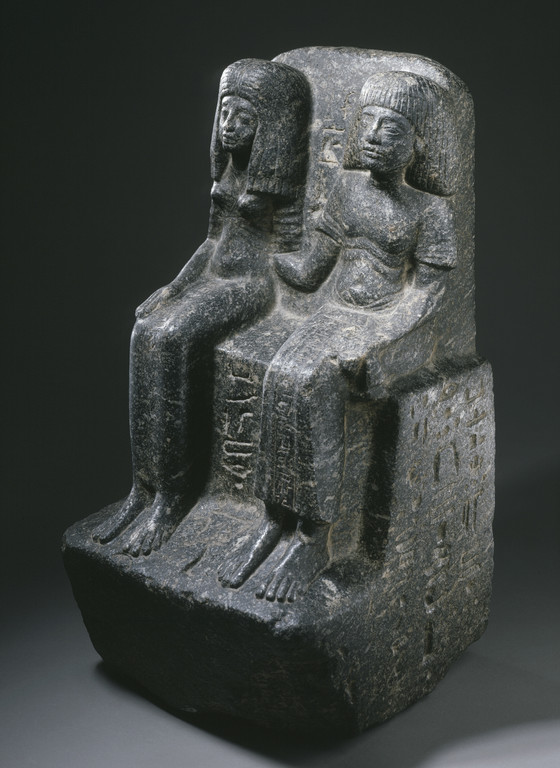This statue of a seated couple, Userhat, King's scribe and overseer of the granaries at Thebes (modern day Luxor), and his wife, Kha, are identified by the hieroglyphic text inscribed on their laps....
This statue of a seated couple, Userhat, King's scribe and overseer of the granaries at Thebes (modern day Luxor), and his wife, Kha, are identified by the hieroglyphic text inscribed on their laps. An inscription on the front of Userhat's kilt describes him as "Royal Scribe of the Granary." The elegant garments and the naturalistic rendering of Userhat's torso suggest a late 18th or early 19th dynasty date. In a gesture of affection, the outline of Kha's hand appears wrapped around Userhat's left arm. The inscription on the statue also expresses their wish to take part in "everything which comes forth from upon the offering table fo Amun of the City [Thebes]...
A visitor to Karnak temple about a century after Userhat and Kha placed their statue in the temple attempted to make the statue his by carving an inscription on the blank sections of the statue. His inscription reads, "Giving plant offerings and incense by the wab priest Pawenhatweser, Son of Ip, his wife, the Lady of the House, Fekar.An offering which the king gives to Nut, that she may give all life and all health to Pawenhatwesir." This inscription can be roughly dated to the Late Period of ancient Egyptian history by Pawenhatwesir's name, which was a common name at that time.
Temples in ancient Egypt were more than places where the gods were worshiped, they represented sacred spaces where the rituals conducted by the priests and the offerings given by worshipers ensured the continual rebirth of the sun each morning in the east. Since temples represented the houses of the gods on earth, ancient Egyptians who could afford to do so often had statues of themselves set up in temple spaces. These statues were meant to represent a perpetual devotional offering to the god of the temple, and also allowed those represented in the statues to take part in the rituals performed and daily offerings made to the temple. Userhat and Kha originally donated the statue to the temple hoping to benefit from such offerings and religious rituals of the temple, and Pawenhatwesir later carved his inscription on the statue for the same purpose.
As one of the largest temples in ancient Egypt, the great Temple of Amun at Karnak (located near modern day Luxor) received many devotional gifts such as statues like the statue of Userhat and Kha, to be set up within its walls. Over the centuries of worship at Karnak's temple, the number of such statues continued to grow, until eventually the kings of the Ptolemaic Period chose to clear out statues of long forgotten donors in order to make room for new statues being offered. Although it was necessary to create more room in the temple, these statues were still considered sacred objects, and so the ancient Egyptians did not destroy them. Instead, they buried them in a pit within the sacred space of the temple where they lay undiscovered until the early twentieth century when they were uncovered by archaeologists excavating at Karnak. LACMA's statue of Userhat and Kha likely came from this discovery, known as the Karnak cachette.
More...



